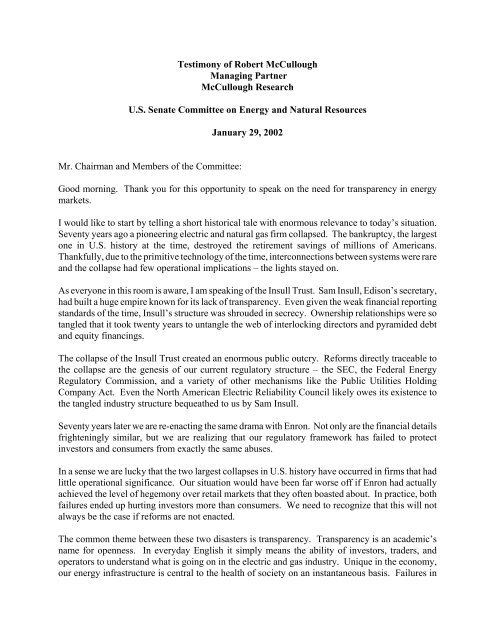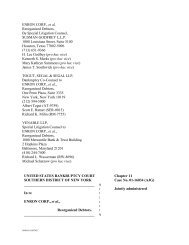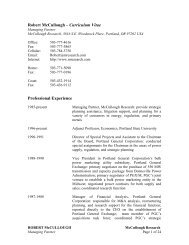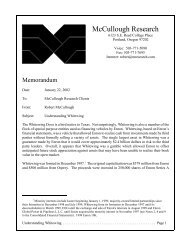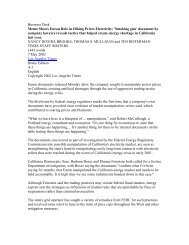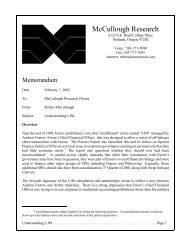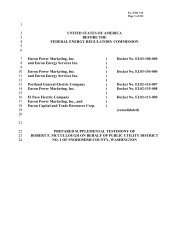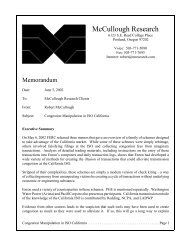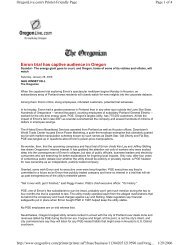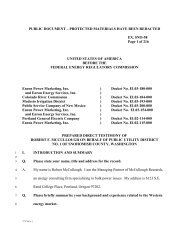Testimony of Robert McCullough before the U.S. Senate Committee ...
Testimony of Robert McCullough before the U.S. Senate Committee ...
Testimony of Robert McCullough before the U.S. Senate Committee ...
Create successful ePaper yourself
Turn your PDF publications into a flip-book with our unique Google optimized e-Paper software.
<strong>Testimony</strong> <strong>of</strong> <strong>Robert</strong> <strong>McCullough</strong><br />
Managing Partner<br />
<strong>McCullough</strong> Research<br />
U.S. <strong>Senate</strong> <strong>Committee</strong> on Energy and Natural Resources<br />
January 29, 2002<br />
Mr. Chairman and Members <strong>of</strong> <strong>the</strong> <strong>Committee</strong>:<br />
Good morning. Thank you for this opportunity to speak on <strong>the</strong> need for transparency in energy<br />
markets.<br />
I would like to start by telling a short historical tale with enormous relevance to today’s situation.<br />
Seventy years ago a pioneering electric and natural gas firm collapsed. The bankruptcy, <strong>the</strong> largest<br />
one in U.S. history at <strong>the</strong> time, destroyed <strong>the</strong> retirement savings <strong>of</strong> millions <strong>of</strong> Americans.<br />
Thankfully, due to <strong>the</strong> primitive technology <strong>of</strong> <strong>the</strong> time, interconnections between systems were rare<br />
and <strong>the</strong> collapse had few operational implications – <strong>the</strong> lights stayed on.<br />
As everyone in this room is aware, I am speaking <strong>of</strong> <strong>the</strong> Insull Trust. Sam Insull, Edison’s secretary,<br />
had built a huge empire known for its lack <strong>of</strong> transparency. Even given <strong>the</strong> weak financial reporting<br />
standards <strong>of</strong> <strong>the</strong> time, Insull’s structure was shrouded in secrecy. Ownership relationships were so<br />
tangled that it took twenty years to untangle <strong>the</strong> web <strong>of</strong> interlocking directors and pyramided debt<br />
and equity financings.<br />
The collapse <strong>of</strong> <strong>the</strong> Insull Trust created an enormous public outcry. Reforms directly traceable to<br />
<strong>the</strong> collapse are <strong>the</strong> genesis <strong>of</strong> our current regulatory structure – <strong>the</strong> SEC, <strong>the</strong> Federal Energy<br />
Regulatory Commission, and a variety <strong>of</strong> o<strong>the</strong>r mechanisms like <strong>the</strong> Public Utilities Holding<br />
Company Act. Even <strong>the</strong> North American Electric Reliability Council likely owes its existence to<br />
<strong>the</strong> tangled industry structure bequea<strong>the</strong>d to us by Sam Insull.<br />
Seventy years later we are re-enacting <strong>the</strong> same drama with Enron. Not only are <strong>the</strong> financial details<br />
frighteningly similar, but we are realizing that our regulatory framework has failed to protect<br />
investors and consumers from exactly <strong>the</strong> same abuses.<br />
In a sense we are lucky that <strong>the</strong> two largest collapses in U.S. history have occurred in firms that had<br />
little operational significance. Our situation would have been far worse <strong>of</strong>f if Enron had actually<br />
achieved <strong>the</strong> level <strong>of</strong> hegemony over retail markets that <strong>the</strong>y <strong>of</strong>ten boasted about. In practice, both<br />
failures ended up hurting investors more than consumers. We need to recognize that this will not<br />
always be <strong>the</strong> case if reforms are not enacted.<br />
The common <strong>the</strong>me between <strong>the</strong>se two disasters is transparency. Transparency is an academic’s<br />
name for openness. In everyday English it simply means <strong>the</strong> ability <strong>of</strong> investors, traders, and<br />
operators to understand what is going on in <strong>the</strong> electric and gas industry. Unique in <strong>the</strong> economy,<br />
our energy infrastructure is central to <strong>the</strong> health <strong>of</strong> society on an instantaneous basis. Failures in
electricity and gas open <strong>the</strong> specter <strong>of</strong> <strong>the</strong> lights actually going out in large areas <strong>of</strong> North America.<br />
Transparency allows policy makers, regulators, investors, entrepreneurs, and consumers to make<br />
intelligent and well founded decisions about <strong>the</strong>ir energy supply. A refrain we hear <strong>of</strong>ten repeated<br />
is that competitive markets don’t operate very well in <strong>the</strong> dark. If we fail to set <strong>the</strong> right policies,<br />
we may actually get to experience this first hand.<br />
Transparency is critical in three different, but closely related, arenas.<br />
Financial Transparency<br />
The first <strong>of</strong> <strong>the</strong>se is financial. Both Enron and Insull were characterized by a bewildering corporate<br />
structure and very sketchy financial reporting. Insull pioneered abuses in interlocking directorates,<br />
pyramided securities, and self-dealing. As <strong>the</strong> weeks pass after Enron’s Chapter 11, we are hearing<br />
exactly <strong>the</strong> same allegations.<br />
One <strong>of</strong> <strong>the</strong> ironies <strong>of</strong> <strong>the</strong> Enron debacle is that if Representative Sam Rayburn, one <strong>of</strong> <strong>the</strong> authors<br />
<strong>of</strong> <strong>the</strong> 1935 Public Utilities Holding Company Act, had had his way, Enron would have been a<br />
registered utility holding company. The stringent reporting and regulatory requirements would very<br />
likely have allowed us to avoid Enron’s implosion. Every arcane financial transaction would have<br />
been on <strong>the</strong> record. Every major decision (and most minor ones) would have been subject to SEC<br />
review.<br />
Now we all know that PUHCA is complex, difficult to apply, and technologically outmoded. In<br />
practice, applying PUHCA has been like gardening with a chainsaw – possibly effective but difficult<br />
to control. I am not proposing that we can easily rehabilitate this tool today. The key is that <strong>the</strong><br />
detailed reporting required under PUHCA would have provided <strong>the</strong> transparency that <strong>the</strong> investors<br />
desperately needed to protect <strong>the</strong>mselves from Enron’s hidden risks.<br />
The investor – even those aided by sophisticated Wall Street analysts – simply did not have <strong>the</strong> data<br />
to make an informed choice. Our detailed dissection <strong>of</strong> just one <strong>of</strong> Enron’s Special Purpose Entities<br />
(SPEs) required massive computer resources, many years <strong>of</strong> experience on <strong>the</strong> ground in <strong>the</strong><br />
industry, and thousands <strong>of</strong> hours <strong>of</strong> pr<strong>of</strong>essional effort.<br />
Whitewing, <strong>the</strong> asset holder that supported <strong>the</strong> investments at Enron and Osprey, is now worth no<br />
more than $2 billion dollars against a book value <strong>of</strong> $4.7 billion. No matter how creative <strong>the</strong><br />
bankruptcy court is in <strong>the</strong> unraveling <strong>of</strong> Enron’s Chapter 11, investors will lose $2.7 billion dollars<br />
from just this one SPE.<br />
The required reforms are straightforward. Off-balance sheet financing does not mean stealth<br />
financing. Whitewing’s income and balance sheets needed to be part <strong>of</strong> <strong>the</strong> reports available to<br />
investors. Massive, billion dollar shifts were frequently made in Whitewing’s structure and only<br />
reported with a line or two in Enron’s 10Qs and 10Ks.
Equally dangerous was Enron’s use <strong>of</strong> mark-to-market revenue and earnings accounting. Enron<br />
apparently calculated <strong>the</strong> proceeds from multi-year transactions based on values from forward<br />
markets that are thin at best and non-existent at worst. One industry pundit called depending on<br />
forward markets in electricity as pricing by rumor. If mark-to-market is used, <strong>the</strong> assumptions<br />
behind <strong>the</strong> calculations must be open for review.<br />
Commercial Transparency<br />
Commercial transparency is also a problem. FERC’s previous chairman, Curt Hebert, recently<br />
appeared <strong>before</strong> this committee and stated that “In today's competitive markets, however,<br />
confidentiality <strong>of</strong> price and customer information can be critical to a utility's success.” One <strong>of</strong> <strong>the</strong><br />
lessons <strong>of</strong> <strong>the</strong> California market failure and Enron’s collapse is that he cannot have been more<br />
wrong.<br />
One <strong>of</strong> <strong>the</strong> ironies <strong>of</strong> <strong>the</strong> California crisis is that <strong>the</strong> <strong>the</strong>oretical pursuit <strong>of</strong> transparency through <strong>the</strong><br />
establishment <strong>of</strong> centralized markets at <strong>the</strong> California ISO and Power Exchange led to <strong>the</strong> filing <strong>of</strong><br />
a tariff at FERC that made almost all commercial information secret. The logic is that commercial<br />
data availability would make gaming <strong>the</strong> centralized markets easier and, <strong>the</strong>refore, in order to protect<br />
<strong>the</strong> competitive process, government must intervene to suppress <strong>the</strong> distribution <strong>of</strong> market data.<br />
In practice, <strong>the</strong> secrecy enforced by <strong>the</strong> ISO has made <strong>the</strong>ir markets completely opaque. Ano<strong>the</strong>r<br />
irony is that in <strong>the</strong> course <strong>of</strong> <strong>the</strong> many investigations currently under way as well as numerous FERC<br />
cases, all commercial information is now readily available to market interests. Only policy makers,<br />
<strong>the</strong> press, and consumers do not have access to market data.<br />
Restriction <strong>of</strong> market information weakened <strong>the</strong> negotiating position <strong>of</strong> consumers and made high<br />
prices far more likely in <strong>the</strong>se markets.<br />
Even today, weak reporting <strong>of</strong> marketers to FERC and restrictive information rules by ISOs make<br />
concentration and abuse in market hubs difficult to monitor. Enron, for example, doesn’t include<br />
market hub information in <strong>the</strong>ir quarterly marketing report to FERC, even though many o<strong>the</strong>r<br />
marketers do. Our only way to know <strong>the</strong> degree <strong>of</strong> market dominance Enron had achieved at certain<br />
hubs is to “reverse engineer” reports from marketers who do report such data in order to calculate<br />
Enron’s share <strong>of</strong> transactions. In doing so, we now know that Enron had achieved a share <strong>of</strong> greater<br />
than 30% <strong>of</strong> transactions at <strong>the</strong> California-Oregon Border.<br />
The relevance <strong>of</strong> such information is critical. On December 3 rd , Enron went into Chapter 11. At <strong>the</strong><br />
same time, forward markets on <strong>the</strong> West Coast fell by 30%. No o<strong>the</strong>r changes in operations,<br />
hydroelectric supply, or fossil fuel prices took place at that time. The clear implication is that Enron<br />
may have been using its market dominance to “set” forward prices.<br />
The negative impacts <strong>of</strong> <strong>the</strong>se policies are not only felt by consumers. Bonneville Power, an agency<br />
<strong>of</strong> <strong>the</strong> Energy Department, posted $337 million in losses last year – losses that reflect a cost in <strong>the</strong><br />
short term to <strong>the</strong> U.S. Treasury. One possible reason is <strong>the</strong> large degree <strong>of</strong> transactions between<br />
Enron and Bonneville during this period.
Transparency, simply put, requires open information for consumers and policy makers. In <strong>the</strong><br />
absence <strong>of</strong> open information market failures are easily disguised and corrective measures are<br />
painfully delayed.<br />
Operational Transparency<br />
The third area where transparency is critical involves system operations. Marketers have been<br />
lobbying FERC, NERC, and <strong>the</strong> Energy Information Administration to restrict information in <strong>the</strong><br />
name <strong>of</strong> competition.<br />
While <strong>the</strong>ir arguments seem specious to long time market participants such as myself, <strong>the</strong>ir energetic<br />
advocacy <strong>of</strong>ten disguises <strong>the</strong> weakness <strong>of</strong> <strong>the</strong>ir arguments. Where system operations are concerned,<br />
granting <strong>the</strong>ir demands may well be catastrophic.<br />
NERC and <strong>the</strong> regional reliability councils were established in response to <strong>the</strong> massive blackout<br />
along <strong>the</strong> eastern seaboard in November 1965. The idea was to promote reliability by coordinating<br />
information between parties. All information was open to <strong>the</strong> public and accessible to policy<br />
makers.<br />
Until 2000, <strong>the</strong> system worked very well. In 2000, <strong>the</strong> system foundered. California emergencies,<br />
we now generally believe, had a strong component <strong>of</strong> market failure. In December <strong>of</strong> 2000, our<br />
utility clients on <strong>the</strong> West Coast simply did not know whe<strong>the</strong>r that <strong>the</strong> emergencies were true or not.<br />
When <strong>the</strong> California crisis started, on May 22 nd , 2000, <strong>the</strong> question <strong>of</strong> whe<strong>the</strong>r <strong>the</strong> high California<br />
prices were due to withholding by California generators or a real capacity shortage was <strong>of</strong> critical<br />
importance to <strong>the</strong> neighboring systems. Upon investigation, we found that <strong>the</strong> California ISO had<br />
effectively classified all <strong>of</strong> <strong>the</strong>ir operating information. We were unable to understand why <strong>the</strong><br />
California ISO’s <strong>of</strong>ficial reports to <strong>the</strong> Western System Coordination Council showed a healthy<br />
surplus – 15% – but <strong>the</strong>y were declaring capacity emergencies every few days. A critical issue was<br />
whe<strong>the</strong>r <strong>the</strong> major <strong>the</strong>rmal units in California were actually being dispatched. The California ISO<br />
was distributing this information to <strong>the</strong> WSCC, which in turn was making it available to market<br />
participants within California. Access, even by WSCC members, outside this small group was<br />
energetically opposed by marketers and <strong>the</strong> California ISO. When we finally raised this issue<br />
publicly in October <strong>of</strong> 2000 and gained access for Pacific Northwest utilities, <strong>the</strong> regulatory<br />
Commissions in Oregon and California, and a variety <strong>of</strong> California state agencies such as <strong>the</strong><br />
California Energy Commission and <strong>the</strong> California Oversight Board, <strong>the</strong> California ISO responded<br />
<strong>the</strong> following day by ceasing to provide this information, citing, in part, access to information by<br />
Oregon state regulators.<br />
How did commercial transparency create this 180 degree reversal <strong>of</strong> public policy? The answer<br />
comes from a lack <strong>of</strong> understanding about competitive markets and <strong>the</strong> importance <strong>of</strong> information<br />
to consumers. The fundamental fact that <strong>the</strong> ISO overlooked is that freedom <strong>of</strong> information makes<br />
markets more efficient. The ISO had no real way <strong>of</strong> judging whe<strong>the</strong>r <strong>the</strong>y were actually facing a<br />
capacity shortage or a problem in <strong>the</strong>ir markets once <strong>the</strong>y had forestalled open debate by classifying<br />
virtually all operational information.
Today, we know that plant operations in 2000 among <strong>the</strong> five major generators only averaged 50%.<br />
Comparable resources – by age, fuel, and size – operated at over 90% in surrounding states over <strong>the</strong><br />
same period. In passing, <strong>the</strong> historical average availability for comparable equipment, by age, fuel,<br />
and size is 84%.<br />
As an historical aside, FERC gradually came to understand <strong>the</strong> importance <strong>of</strong> this data and<br />
established a “must <strong>of</strong>fer” rule for <strong>the</strong> California generators as part <strong>of</strong> <strong>the</strong>ir repair package at <strong>the</strong><br />
California ISO. This rule, combined with a price ceiling, returned <strong>the</strong> California market to<br />
competitive levels. It also appears to have reduced <strong>the</strong>rmal plant outages from 50% to 10% in a<br />
matter <strong>of</strong> weeks.<br />
The lack <strong>of</strong> reliable operational information brought <strong>the</strong> system very close to disaster. The<br />
hydroelectric reservoirs in British Columbia, Oregon, and Washington are finite. Water stored in<br />
<strong>the</strong>se reservoirs are <strong>the</strong> last insurance policy against system collapse. If <strong>the</strong> California emergencies<br />
really reflected a capacity shortage ra<strong>the</strong>r than a market failure, it would have been critical to<br />
maintain this insurance policy.<br />
As it turned out, <strong>the</strong> Secretary <strong>of</strong> Energy, on <strong>the</strong> basis <strong>of</strong> insufficient information, directed <strong>the</strong> U.S.<br />
systems to draw down this insurance policy in order to serve everyday loads in California. If winter<br />
wea<strong>the</strong>r in British Columbia, Oregon, and Washington had turned harsh, blackouts <strong>of</strong> substantial<br />
duration might well have resulted.<br />
The fault was not with <strong>the</strong> Secretary <strong>of</strong> Energy. The fault was in an ISO tariff that restricted <strong>the</strong><br />
information available to policy makers.<br />
In <strong>the</strong> absence <strong>of</strong> data, we cannot have an informed debate. In <strong>the</strong> absence <strong>of</strong> an informed debate,<br />
we can and <strong>of</strong>ten do make <strong>the</strong> wrong decisions.<br />
The first two forms <strong>of</strong> transparency discussed above, financial and commercial, only affect dollars<br />
– losses to investors and overcharges to consumers. The loss <strong>of</strong> transparency in <strong>the</strong> area <strong>of</strong> system<br />
operations was vastly more critical. We came close to shutting <strong>of</strong>f light and heat to millions <strong>of</strong><br />
consumers in January and February 2000 – only a year ago – because we drew down our reserves<br />
several months too early.<br />
The right policy direction is to guarantee transparency to investors, consumers, and operators. The<br />
result <strong>of</strong> <strong>the</strong> collapse <strong>of</strong> <strong>the</strong> Insull Trust in 1932 was to make information available to policy makers<br />
and <strong>the</strong> public. The implications <strong>of</strong> <strong>the</strong> Enron collapse <strong>of</strong> 2001 is that we have allowed <strong>the</strong> resolve<br />
<strong>of</strong> our parents and grandparents to dissipate.<br />
If we fail, and <strong>the</strong> evidence from <strong>the</strong> Enron debacle is that we are failing, we may really get <strong>the</strong><br />
chance to explore competitive markets in <strong>the</strong> dark.<br />
Thank you.


